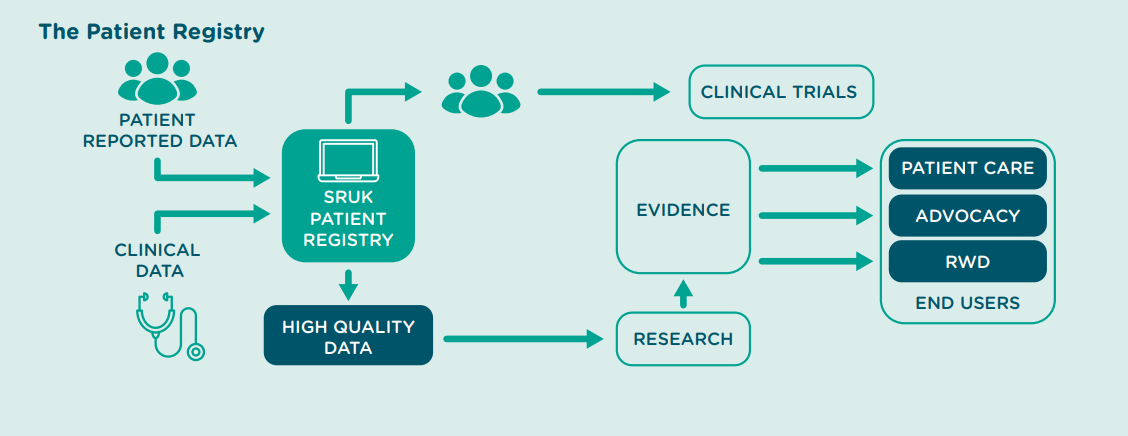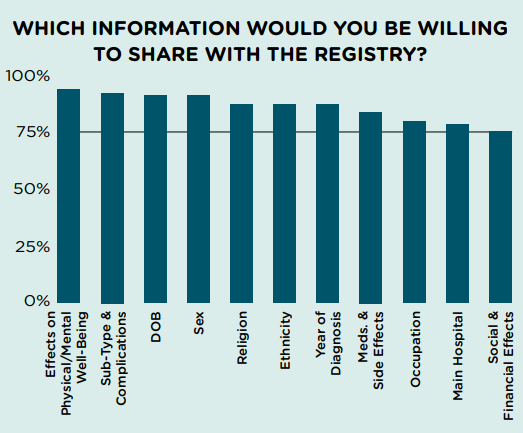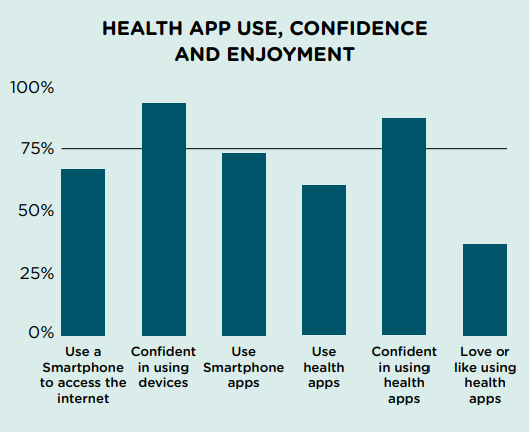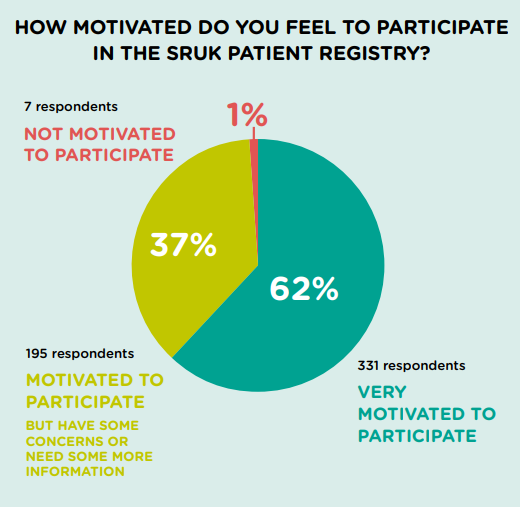Sharing Data to Improve Lives: The SRUK Patient Registry Survey
SRUK is developing a Patient Registry, with the aim of improving outcomes for people diagnosed with Scleroderma or Raynaud's. Our Registry will be a secure, anonymous database, containing health information about people living with the conditions. It will be used to improve our understanding of Scleroderma and Raynaud's and how different people are affected over time, to help accelerate research into new and better treatments designed to improve quality of life. Read on to find out what we learned through the SRUK Patient Registry Survey, and how it will help shape our Patient Registry.
As part of our research strategy, SRUK aspires to advance research into the areas of early diagnosis and detection, precision medicine, quality of life, and the causes of Scleroderma & Raynaud's.
Scleroderma experts have suggested that developing an SRUK Patient Registry would be a powerful resource to gather data for research and provide real-world evidence on the conditions. This data could enable SRUK and other organisations to better advocate for improved care and access to treatments.
Our ambitions to develop this Registry can only succeed if people living with Scleroderma and Raynaud's are willing to take part. In April, we reached out to our community through the SRUK Patient Registry Survey, to find out your views.
The SRUK Patient Registry
A Patient Registry is an organised system that collects uniform data on people with a particular medical condition. A rich dataset will be collected over time and used to:
- Advance research into Scleroderma and Raynaud's,
- Identify appropriate patients for clinical trials of new treatments, and
- Develop real-world evidence of how different groups respond to certain treatments and care. This Real World Data (RWD) is important in developing our understanding of how people are doing in everyday life as opposed to controlled clinical trial environments. It will enable SRUK and others to advocate for better care for patients.
The Registry will be developed as a secure database that holds anonymised health data on people diagnosed with Scleroderma and Raynaud's. As a patient organisation, we aspire to put those living with the conditions at the forefront and offer everyone the opportunity to participate, regardless of where they are treated. This will provide a comprehensive picture of how patients are doing across the country, and not just within specialist centres.

The Survey
The Registry Survey was launched in April and promoted through our social media and e-news. It was open to participants aged 16+, including the carers of children and adults living with the conditions. The survey explored our community's attitude to reporting and sharing data, the use of anonymised data in research, internet literacy, and overall motivation to participate in the Registry.
Who Responded?
530 people completed our survey before September 2023.
- 51.6% had either diffuse, limited systemic, or sine scleroderma.
- 36% had Raynaud's only.
- 8.44% had mixed connective tissue disease.
- 1.88% reported localised scleroderma.
- A small number were carers of affected children.
The majority were UK-based and treated at a range of specialist and non-specialist centres. Nineteen people reported living overseas.
The majority of responses came from white females, aged 45-74 years old, so we are working on ways we can gather more insight from men, people of non-white backgrounds and different age groups, and from carers of affected children.
What type of data are people willing to share?

We first asked whether people would be willing to share information related to their symptoms and their effects upon day-to-day life. Everyone was either willing (82.18%) or maybe willing (17.82%) to share this information.
Over 90% of respondents reported a willingness to share information on:
- Effects of Scleroderma and Raynaud's on physical and mental wellbeing,
- Disease sub-type,
- Organ complications.
This can provide insight into the impact of the conditions and help enable SRUK, healthcare professionals and researchers to identify those requiring new treatments and methods of care.
Lifestyle Information
Over 80% indicated they would share information regarding:
- Their region,
- Ethnic background,
- Year of diagnosis,
- Medications and side-effects,
- Occupation/previous occupations.
Knowing where patients are based will allow us to see how people with Scleroderma and Raynaud's fare across the country and help address disparities in care. Similarly, understanding differences in the effects of the conditions within different ethnic groups could help us better understand the risk of progression among different ethnicities, and advocate for better screening for those at highest risk of developing complications and severe disease. Likewise, knowing when patients were diagnosed would also assist our understanding of disease progression.
Knowing past and present occupations has the potential to give insight into environmental factors that could trigger Scleroderma and Raynaud's. It is also useful to understand whether people have been forced to step back from work, to show the wider effects of the disease.
Over 75% indicated that they would share information regarding:
- The main hospital where they receive care.
- The social and financial effects of their condition on them and their family.
Knowing where people are treated and how this is linked to their outcomes could help further highlight disparities in care.
Scleroderma often strikes people in the prime of their life when they may have dependent children or family members. The social and financial effects upon the individual and their extended family are currently poorly understood. Having access to data on these impacts would be a powerful tool in understanding the extent to which people are able to continue working and would help us advocate for change to help you stay in employment for longer.
Sharing the Data
Because Scleroderma is a rare disease, we can make more of an impact by giving other parties access to the data to carry out research, and by combining SRUK Registry data with other international datasets. Therefore, we would need to provide access to anonymised participant data (so individuals cannot be identified) to some external parties via a secure environment, such as:
- Researchers.
- Healthcare professionals (for research and to identify those suitable for clinical trials).
- Certain companies, such as pharmaceuticals, who might be interested in using the data to plan therapeutics or see how their drugs are performing, or to gain insight into the patient experience of treatments.
Data access requests would be considered by an independent committee with patient representation. We could also enrich patient reported data by linking with other data sources like NHS data.
Over 90% of respondents suggested that they would or may be willing to share or link their data with the NHS, researchers, clinicians, and companies (i.e. pharmaceuticals), and 95% indicated they'd like to be contacted if they were eligible for a clinical trial.
How do people want to provide their data?

Individuals can contribute information to a Patient Registry through an online patient portal, such as an app or secure website. We therefore need to understand our community's attitudes to the internet and apps, and how you feel about using these platforms.
Our survey revealed high levels of smartphone use, internet access, and use of health apps. More than 60% of respondents regularly or sometimes use health apps, reporting high confidence in using them. 37% indicated they love or like using these apps, and 13% of respondents indicated that they do not enjoy using them.
This is a topic which we will explore further to ensure a solution that is accessible for all members of our community.
How motivated are patients to participate in the Registry?

Our last question was undoubtedly the most important: to understand how motivated our community is by this project. 99% of all those who responded said that they were very motivated or motivated to participate in the SRUK Patient Registry! There was a strong desire to participate across all condition sub-types.
Thank you to everyone who participated in this vital piece of work to help plan the Registry. By continuing to shape the direction of the Registry with the perspectives of our community at the forefront, we hope to create a powerful resource that will benefit everyone living with Scleroderma and Raynaud's.
We are still keen to hear our community's perspectives, and are especially interested to hear from men, people who identify as BAME, are carers of children with scleroderma. If you would like to participate, please click here to access the survey and share your views!
